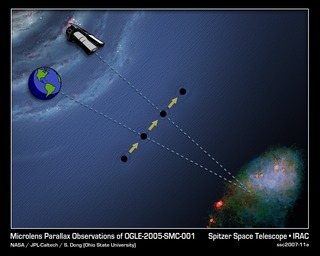
News Release • May 30th, 2007 • ssc2007-11 •
Astronomers now have a new "eye" for determining the distance to certain mysterious bodies in and around our Milky Way galaxy. By taking advantage of the unique position of NASA's Spitzer's Space Telescope millions of miles from Earth, and a depth-perceiving trick called parallax, they were able to pin down the most probable location of one such object. The findings will ultimately help astronomers better understand the different components of our galaxy.
"Forty years ago a visionary astronomer named Dr. Sjur Refsdal theorized that dark bodies could be located using parallax and a space telescope," said Andrew Gould of Ohio State University, Columbus, Ohio, who led the project. "It is truly remarkable that we have been able to prove him right with this Spitzer observation."
Spitzer is the only telescope that orbits the sun behind Earth, and is the farthest telescope from us with the ability to study distant stars. Currently, Spitzer is about 40 million miles (70 million kilometers) away from Earth. It will continue to drift farther and farther away at a rate of about 10 million miles (15 million kilometers) per year.
This great distance gives astronomers a great advantage. They can use Spitzer in the same way that a human brain uses two eyes to tell how far away objects are, a principle called parallax. With two eyes, we have two perspectives, which our brains combine to give us depth perception. In space, Spitzer acts as one eye, while a ground-based telescope acts as the other. With two very wide cosmic eyes, astronomers can determine the location of bodies within and just outside our galaxy.
Gould and his team are the first to use Spitzer to perform this astronomical feat. Their goal was to determine whether a previously identified dark matter candidate, called a massive compact halo object, or "Macho," is within our galaxy and contributing to its overall weight.
Our galaxy is heavier than it looks, with at least 80 percent of its mass consisting of mysterious, invisible dark matter. A large fraction of this dark matter is the exotic kind, different from the ordinary matter that makes up the familiar world around us. The rest might be so-called machos, which are ordinary-matter dark bodies that lurk in our galaxy's halo, the region that sits above and below its spiral disk. They are thought to be a combination of black holes, very faint stars and isolated planets.
Several suspected machos have been discovered in the past through a technique called microlensing, in which the dark bodies' gravity causes light from a passing background star to bend and brighten. But astronomers do not know whether these candidates are indeed machos in the galaxy halo, or other, non-macho objects just outside the Milky Way in small satellite galaxies. By pinpointing the location of the candidates, astronomers will learn whether they are in the halo and thus machos. This information, in turn, will help them figure out how much machos contribute to the total mass of our galaxy.
OGLE-2005-SMC-001 is one such macho candidate. It was first discovered by Andrzej Udalski, of the Optical Gravitational Lens Experiment (OGLE), and Warsaw University Observatory, Warszawa, Poland. Udalski and colleagues noticed that the dark object was causing a passing, background star to brighten. Gould and his team quickly sprang to action, following up with Spitzer observations of the short-lived event.
The data from both telescopes, or "eyes," were then combined and modeled through a series of complicated equations. The results indicate with 95 percent probability that OGLE-2005-SMC-001 is dark matter in our galaxy's halo and therefore a part of its overall mass.
In addition, the data show that OGLE-2005-SMC-001 consists of two bodies circling around each other. Gould and colleagues think the objects could be a pair of black holes, a very rare sighting in our universe. However, there is a small chance this feature is actually just a regular pair of orbiting stars in a neighboring, satellite galaxy.
"It will be very exciting to locate and measure the masses of more dark objects in the future by applying this technique. And we might finally be able to unravel the mystery of machos," said Subo Dong of Ohio State University, whose paper on OGLE-2005-SMC-001 has been accepted for publication in Astrophysical Journal. Dong presented the results today at a press conference, at the 210th meeting of the American Astronomical Society in Honolulu, Hawaii.
NASA's Jet Propulsion Laboratory, Pasadena, Calif., manages the Spitzer Space Telescope mission for NASA's Science Mission Directorate, Washington. Science operations are conducted at the Spitzer Science Center at the California Institute of Technology, also in Pasadena. Caltech manages JPL for NASA.






